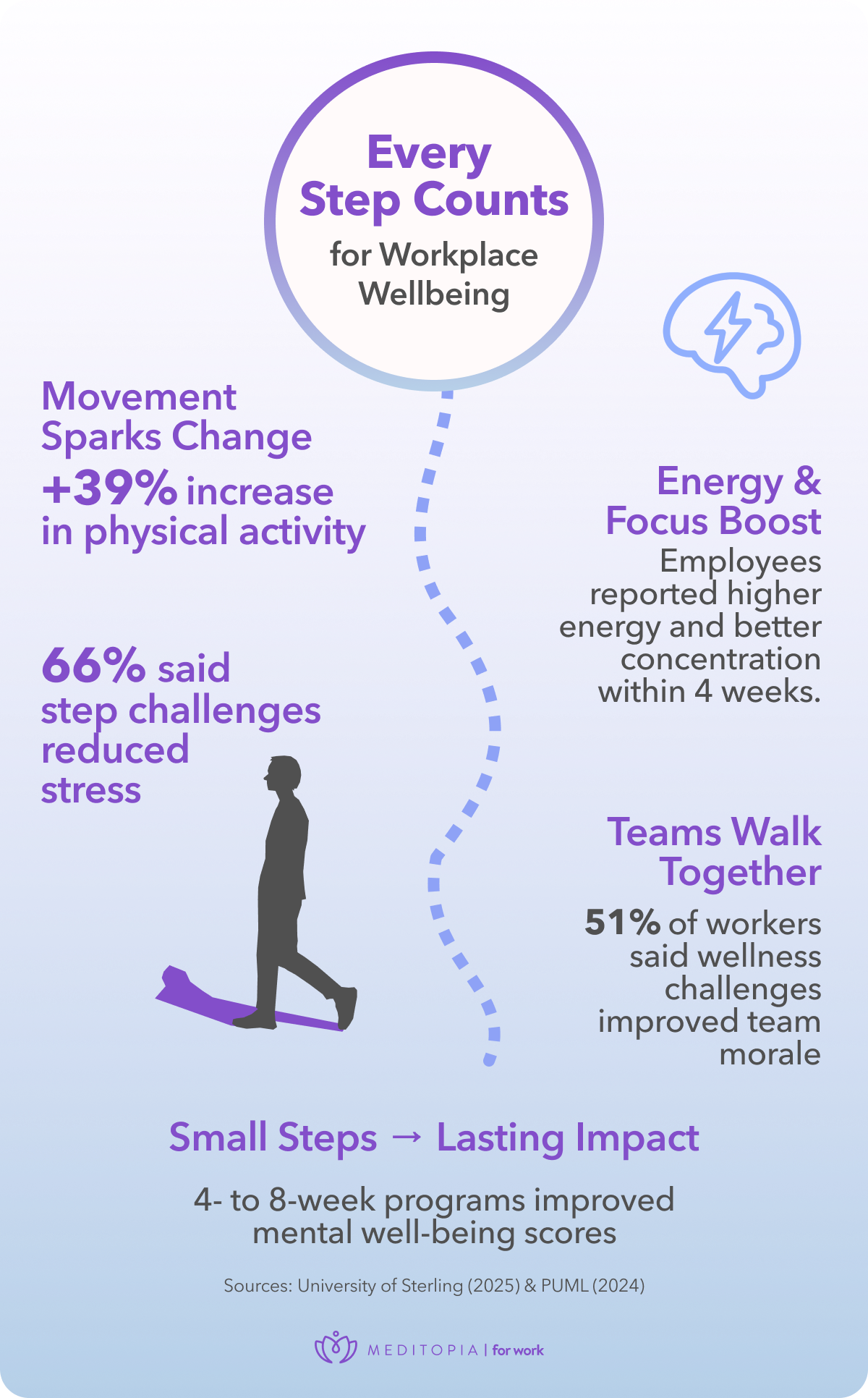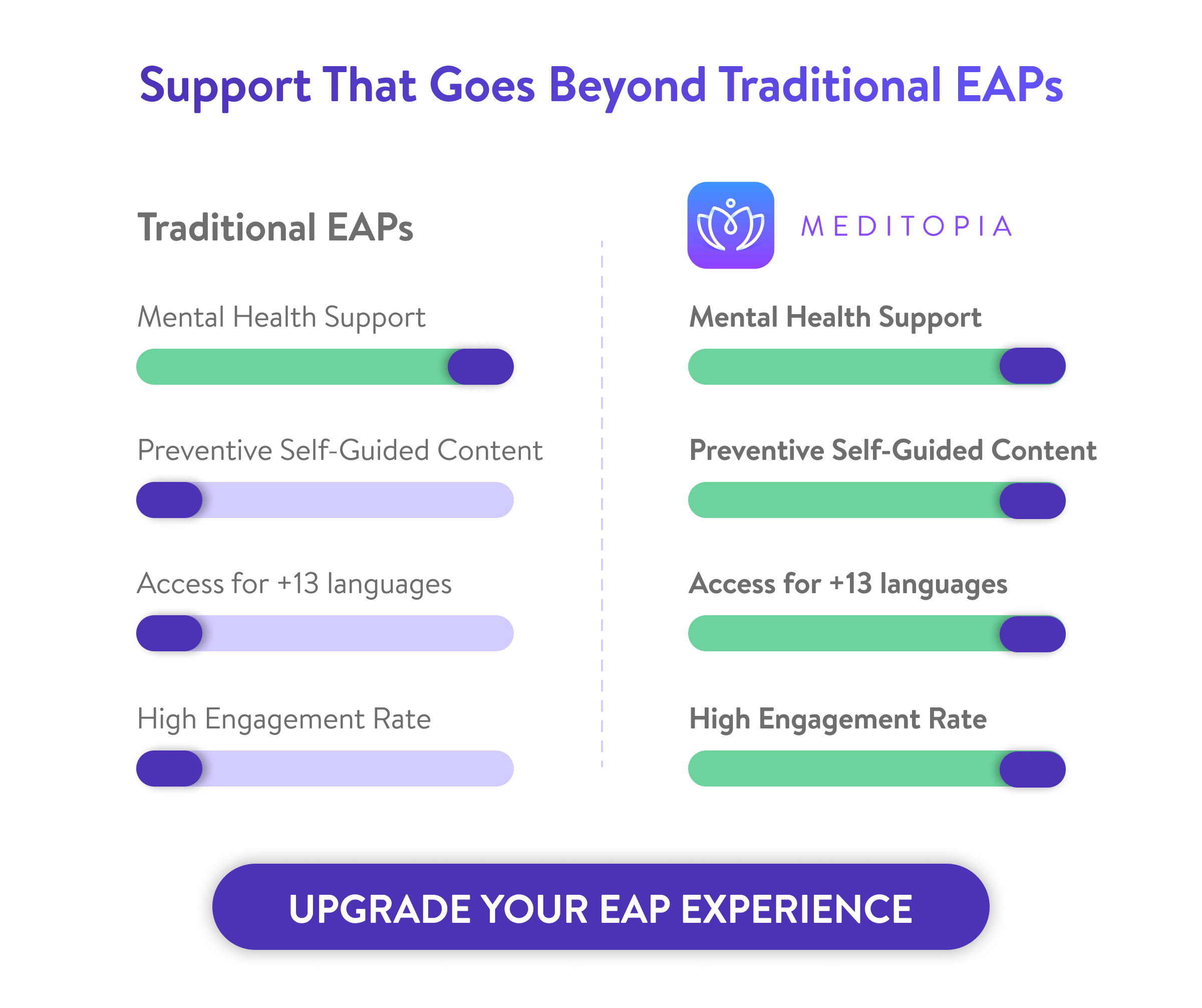Adults now spend over 60% of their waking hours sitting, and this inactivity costs companies up to $54 billion each year in lost productivity [1]. As organisations search for practical ways to energise teams and reduce health-related costs, one simple yet powerful solution stands out: corporate step and walking challenges. Let's discover how they can help your company.
Why Step Challenges Help Corporate Wellness
Walking is fun, but doing with your work besties, is even better. Here’s how a step challenge at work drives both physical and psychological benefits, and why HR teams should consider them a strategic piece of their corporate movement initiatives.
- Promotes daily movement and heart health:
- Sedentary behaviour is a growing concern: in the UK, employees were found to spend about 84% of their time sitting [2].
- Meanwhile, a structured step count challenge over four or eight weeks improved physical fitness (vs control) in that same study.
- Walking and step targets (e.g., 10,000 steps) are simple and measurable ways to reduce sitting time, improve circulation and support cardiovascular wellbeing.
- Creates shared team goals and camaraderie (engagement through wellness):
- When individuals or teams work toward a visible target (daily steps, team totals, leaderboard) it fosters social connection and healthy competition.
- For example a study of a pedometer-based programme found reductions in psychological distress and sustained improvements at eight-month follow-up [3]
- Team step challenges craft an environment of peer support, friendly rivalry and a common mission, all positive for team wellness and culture.
- Improves focus, energy and work performance
- The relationship between physical activity and cognitive/mental outcomes is well documented: healthier employees tend to be more engaged, less prone to burnout, and more productive [4].
- Re-energising breaks via walking help reduce fatigue and improve alertness, boosting overall physical wellbeing at work.
- Easy to implement with minimal setup and scalable
- One of the biggest advantages of a workplace step challenge is that the barrier to entry is low: many employees already carry phones with step-tracking, you just need the customized challenge app.
- Leaderboards and simple dashboards turn the initiative into a gamified wellness tool that can scale to hybrid, remote and global teams. Meditopia for Work can take care of these implementations and internal challenge promotions for you.
- Supports broader health promotion at the workplace:
- Walking is inclusive (versus high-intensity workouts) and fits into busy schedules.
- Incorporating it into a broader wellness strategy means integrating it with mental health, movement breaks and care for employee lifecycle.
- A study on a 100-day 10,000-step programme found improved mental health outcomes (even if the benchmark wasn’t always met) [5]
In short: for HR teams seeking an accessible, measurable, and culture-boosting wellness initiative, a team step challenge is an excellent component of your employee wellbeing arsenal.

How to Organise a Step Challenge at Work
To make your work step challenge successful, here’s a structured framework:
- Set a time frame
- Choose a duration of ~1–2 weeks for a pilot or full-scale challenge. In the end, this allows you to gather data to craft longer challenges, which matters because four weeks is sufficient to kick behavioural habits, as shown in the Scottish study [6].
- Pick a tracking method
- Options include wearables (Fitbit, Apple Watch), built-in phone pedometer apps (Apple Health, Google Fit) or a wellness platform. Meditopia can craft specific instructions to help your team with all the tech parts.
- Allow BYO devices, ensure remote/hybrid employees can participate, and consider manual entry or apps for those without wearables.
- Use dashboards that aggregate data, show live leaderboards and team progress, making the challenge visible and social.
- Create team or individual goals
- Decide if your challenge is individual (everyone tries to hit 10,000 steps day) or team-based (teams aggregate steps). Research shows team formats boost social connection and often engagement [7].
- Set meaningful, inclusive targets: for example, 7,000–10,000 steps daily (depending on your workforce baseline), or cumulative targets like “walk the equivalent of two city marathons as a team”.
- Consider tiers: beginners, intermediate, advanced. So less active employees feel included and not overwhelmed (supports inclusive corporate movement initiatives).
- Promote participation
- Use internal channels: Slack/Teams announcements, email blasts, intranet banners, posters in offices. Use visuals and emphasise the communal aspect.
- Ensure leadership involvement: when managers visibly participate the initiative gains credibility and influence.
- Communicate the benefits clearly: improved physical health, mental wellbeing, team bonding, fun.
- Celebrate progress and winners
- Highlight milestones (e.g., 100 million steps company-wide, teams reaching target).
- Use recognition: digital badges, mentions in newsletters, small rewards (extra break, wellness voucher).
- Share stories: spotlight employees or teams who overcame barriers, reinforcing culture, not only competition.
- Post-challenge follow-up
- Survey participants: ask about experience, steps tracked, wellbeing changes, suggestions.
- Use insights to plan next challenge (whether stepped up, sustained or refreshed).
- Consider turning the step challenge into a recurring feature (quarterly or bi-annual) so it becomes part of your worksite wellness participation strategy.
12 Step Challenge Ideas for the Workplace
Most workplace wellness challenges fail because they focus only on counting steps, not on creating meaningful engagement. Below you’ll find tried-and-tested and creative work step challenge ideas that blend inclusivity, fun, and measurable impact.
10 Office Walking Initiatives That Complement Step Challenges
To sustain momentum beyond the core step challenge, here are lighter, office-friendly initiatives that support ongoing movement and help embed a walking culture:
- Walking meetings: Replace seated meetings with short walks (individually, in pairs or small groups). Encourages movement and often more dynamic conversation.
- “Take the stairs” day: Designate a day each week where employees are encouraged to skip elevators and use stairs.
- Designated walking zones or routes: Map out indoor/outdoor routes employees can use during breaks; mark distances; provide step-count suggestions.
- Post-lunch walking clubs: Schedule a 10-15 minute group walk after lunch; promotes social interaction, post-meal movement and breaks up the sedentary afternoon slump.
- Outdoor company walks or “walk & talk” events: Organise monthly or quarterly walks (e.g., nearby park, city block) during which leaders join, talk culture or strategy in informal mode.
- Walk & Learn Sessions: Replace traditional lunch-and-learns with guided walking talks or podcasts on wellbeing and leadership. Employees listen while walking together or individually.
- “Steps for Recognition” Board: Every 1,000 steps equals one recognition point. Employees can gift points to peers who supported them that week.
- Creative Route Mapping: Encourage employees to “draw” shapes or words using GPS-tracked routes during breaks. It's fun!
- Mindful Morning Loops: Start each day with a 5-minute mindful office loop guided by a Meditopia track, especially effective before meetings or shift starts.
- Seasonal Walking Events: Host themed walking days (e.g., “Spring Reset Walk”, “Autumn Gratitude Trail”) aligned with wellbeing campaigns.
Movement Challenges for Employees With Reduced Mobility
Not every employee experiences movement in the same way, and that’s exactly why inclusive wellness design matters. With a few intentional adjustments, you can turn a walking challenge into a movement challenge that celebrates every form of activity and contribution.
- Shift the focus from “steps” to “movement minutes”: Instead of only counting steps, allow participants to track any form of movement, wheelchair propulsion, stretching, yoga, physiotherapy sessions, or seated cardio.
- Introduce activity conversion charts:
Create an internal equivalency guide, e.g.:- 10 minutes of seated stretching = 1,000 steps
- 15 minutes of resistance band work = 2,000 steps
- 20 minutes of wheelchair rolling = 3,000 steps
- Use digital wellness leaderboards that accept manual or adaptive input: Choose a tracking platform (like Meditopia’s) that allows employees to log custom activity types, so the challenge remains engaging without penalising anyone for mobility differences.
- Promote team-based, not purely individual, formats: In team challenges, collective targets (total steps or total active minutes) encourage support, empathy, and inclusion. Teammates can celebrate diverse ways of contributing rather than only counting personal tallies.
- Encourage storytelling, not just statistics: Invite participants to share how they achieved movement each day, whether through adaptive sports, physiotherapy, or mindfulness walks. Qualitative stories often build more connection than numbers.
Ways to Launch a Step Challenge Program
- Use free tracking apps or built-in phone pedometers: Many employees already own smartphones with step-tracking capability (Apple Health, Google Fit). This reduces cost and barrier to entry.
- Encourage BYO (bring-your-own wearable) participation: Rather than purchase devices, let participants use devices they already have (smartwatch, fitness band, phone). Incentivise transparency and peer sharing rather than focusing on premium gear.
- Offer simple incentives: Consider extra break time, wellness credits, digital badges, recognition in all-staff communications. Even non-monetary rewards (leaderboard shout-outs) can suffice when paired with meaningful goals.
- Combine with existing wellness programmes for better adoption: Link the step challenge to broader wellness themes (mental health, stress reduction, mindfulness) and use internal wellness channels to build awareness.
- Ensure inclusive participation: Make sure remote employees, different time zones and varying fitness levels feel included. Offer alternatives (e.g., walking during local hours, flexible goals).
- Build communications cadence: Pre-launch teaser, kick-off event, mid-point check-in, “last week push”, closing celebration. Use multiple channels (email, Slack/Teams, posters, intranet) to keep the challenge front of mind.
- Leadership endorsement: Have senior leadership kick off the challenge, send encouragements during the period and publicly recognise winners. That dramatically increases engagement.
Measuring the Impact of a Step Challenge
Measurement is often the differentiator between an “event” and a strategically impactful programme. Here are key metrics and how they can tie into your broader employee engagement through wellness KPIs, and how Meditopia’s analytics tools support this.
Key Metrics to Track
- Participation rate: What percentage of the workforce signed up, active daily/weekly participation.
- Average steps per employee: Before vs during challenge vs post-challenge (if you collect baseline).
- Team vs individual performance: Which teams aggregated most steps, variance across departments/geographies.
- Self-reported wellbeing improvement: Include short survey items on energy levels, mood, focus or job satisfaction.
- Retention or absenteeism trends: Compare leave records, turnover intention or presenteeism before and after the challenge period (recognising this is influenced by many factors).
- Engagement in broader wellness programmes: Did participation in the step challenge correlate with uptake in other wellness initiatives?
- ROI indicators: While direct causation is difficult, you can track cost of programme vs estimated gains (e.g., reduction in absentee days × average cost per day).

How Meditopia’s Dashboard Fits
- Real-time tracking of steps across teams: Visible leaderboards and aggregated data help HR spot low-participation areas and intervene.
- Analytics on participation, duration, drop-off: Understand when drop-off occurs and what employee segments disengage.
- Integration with wellness usage: Link step challenge data to broader platform engagement (e.g., mindfulness sessions, coaching) so you see combined impact on employee health and physical wellbeing at work.
- Custom reporting for leadership: Provide concise dashboards showing high-level KPIs (participation, average change, correlation with retention/engagement) to support executive decisions.
- Qualitative feedback: Built-in surveys allow you to capture employee voice: Did they feel more energised? Did they value the competition? Would they participate again?
























